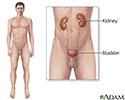Glucose urine test
Urine sugar test; Urine glucose test; Glucosuria test; Glycosuria test
The glucose urine test measures the amount of sugar (glucose) in a urine sample. The presence of glucose in the urine is called glycosuria or glucosuria.
Glucose level can also be measured using a
blood test
or a
cerebrospinal fluid test
.
Blood test
A blood glucose test measures the amount of a sugar called glucose in a sample of your blood. Glucose is a major source of energy for most cells of t...

Cerebrospinal fluid test
A CSF glucose test measures the amount of sugar (glucose) in the cerebrospinal fluid (CSF). CSF is a clear fluid that flows in the space surrounding...
How the Test is Performed
After you provide a urine sample, it is tested right away. The health care provider uses a dipstick made with a color-sensitive pad. The color the dipstick changes to tells the provider the level of glucose in your urine.
If needed, your provider may ask you to collect your urine at home over 24 hours . Your provider will tell you how to do this. Follow instructions exactly so that the results are accurate.
Collect your urine at home over 24 hour
The urine 24-hour volume test measures the amount of urine produced in a day. The amount of creatinine, protein, and other chemicals released into t...

How to Prepare for the Test
Certain medicines can change the result of this test. Before the test, tell your provider which medicines you are taking. Do not stop taking any medicine before talking to your provider.
How the Test will Feel
The test involves only normal urination. There is no discomfort.
Why the Test is Performed
This test was commonly used to test for and monitor diabetes in the past. Now, blood tests to measure glucose level in the blood are easy to do and are used instead of the glucose urine test.
The glucose urine test may be ordered when the doctor suspects renal glycosuria. This is a rare condition in which glucose is released from the kidneys into the urine, even when the blood glucose level is normal.
Normal Results
Glucose is not usually found in urine. If it is, further testing is needed.
Normal glucose range in urine: 0 to 0.8 mmol/l (0 to 15 mg/dL)
The examples above are common measurements for results of these tests. Normal value ranges may vary slightly among different laboratories. Some labs use different measurements or test different samples. Talk to your health care provider about the meaning of your specific test results.
What Abnormal Results Mean
Higher than normal levels of glucose may occur with:
-
Diabetes
: Small increases in urine glucose levels after a large meal are not always a cause for concern.
Diabetes
Diabetes is a chronic disease in which the body cannot regulate the amount of sugar in the blood.
 ImageRead Article Now Book Mark Article
ImageRead Article Now Book Mark Article -
Pregnancy: Up to half of women have glucose in their urine at some time during pregnancy. Glucose in the urine may mean that a woman has
gestational diabetes
.
Gestational diabetes
Gestational diabetes is high blood sugar (diabetes) that starts or is first diagnosed during pregnancy.
 ImageRead Article Now Book Mark Article
ImageRead Article Now Book Mark Article - Renal glycosuria: A rare condition in which glucose is released from the kidneys into the urine, even when blood glucose levels are normal.
Risks
There are no risks with this test.
References
McPherson RA, Ben-Ezra J. Basic examination of urine. In: McPherson RA, Pincus MR, eds. Henry's Clinical Diagnosis and Management by Laboratory Methods . 22nd ed. Philadelphia, PA: Elsevier Saunders; 2011:chap 28.
Review Date: 3/1/2016
Reviewed By: Walead Latif, MD, Nephrologist and Clinical Associate Professor, Rutgers Medical School, Newark, NJ. Review provided by VeriMed Healthcare Network. Also reviewed by David Zieve, MD, MHA, Isla Ogilvie, PhD, and the A.D.A.M. Editorial team.

